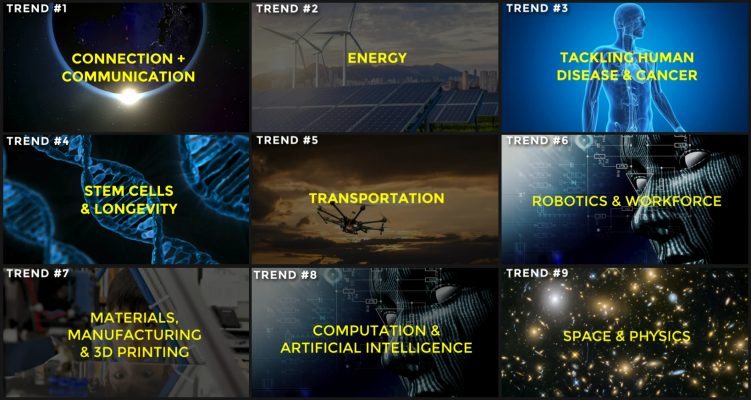Just returned from a few days in Los Angeles meeting with about 199 other intense, independent thinking Entrepreneur Owner-Managers engaged in discussing the convergence of technologies and how they affect our organizations and our lives, in a meeting facilitated by Peter Diamandis. Whoa.
Peter H. Diamandis, “Proof We’re Living in 2017—9 Trends”, as presented at the 2017 Abundance 360 Summit.
The context or framing for the discussion is convergence: that the unceasing exponential increase in speed of computing, coupled with the continued exponential decrease in cost of computing, in the environment of the ubiquitous free high speed broadband—has resulted in unintended consequences—some good, some not so good. The idea is that it is not the standalone change in any one of these discrete domains that matters, it is the literally jumping together of the domains, the convergence of them that is causing the unanticipated disruption. I emerged from our meeting persuaded that the underlying premise is not so much about the domains of change as it is the rate of change, which is palpably increasing, even from one year ago.

Part One. So which technologies are so rapidly morphing and converging over the next several years they will profoundly change our lives? What are the “top of mind” takeaways of technology convergence that are at the knee of the exponential curve and are changing at a rate that may take us by surprise and provide “tipping points” for our us, our families, our enterprises?
AI, Robotics, 3D Manufacturing, Sensors. Global high-speed no-cost connectivity is expected to be largely complete by 2020—digitally accessible objects will grow from about 10 million today to about 50 million in 2020. Naturally it is all wireless—there will be little need for wires with the new 5G. There will be about 5 billion more connected people in the world than there are today each of whom will be able to be connected 24 x 7, contributing to the global on-line dialogue for good or for ill.
Everything—that’s every-thing will be connected. Why not? Sensors are so incredibly cheap and battery life for them is increasing logarithmically. That is, every piece of manufacturing equipment. Every vehicle. Every appliance in your home. Sensors with year-long batteries have become so incredibly inexpensive that they will (literally) be on your door knob. With enough sensors, you can know anything you want in the physical world any time you want. Think of the implications this has. Trillions of sensors around the world means radical transparency is here. Privacy? Hmm…
What’s different about connected robotics for example? Well, remember when we were in the 4th grade learning our “times tables”? Remember how some kids “got it” and others didn’t? With connected machine learning, when one robot “learns” something, they all learn it. Perfectly. At the same time. And never ever forget it.
Autonomous Vehicles. Look, many of you know I have been professionally skeptical about the speed of adoption of autonomous vehicles, but I just got religion. I became a Believer by the data shown in our meeting with Jeff Holden, Chief Product Officer for Uber (you may recognize his name as he’s credited with conceiving and championing Amazon Prime while at Amazon). The data that grabbed me is that vehicle use in North America today is only 4% of theoretical capacity. Where there are no alternatives, I guess that is homeostasis. But what if Uber, or another firm, is able to show you that your current $20,000 all-in cost of driving per year (capital cost, fuel, registration, taxes, insurance—it’s probably low for someone who drives 12,000 miles per year) can be matched by paying Uber say, $5000? Still don’t have your attention? What if they take the most expensive part out of it (the driver) and an autonomous Uber costs $1,500 per year to take you the same mileage per year you drive today?
What if you knew you had a car “on call” 24 x 7, and you never had to wait more than 5 minutes, and you never had to look for (or pay for) a parking space ever again? What are the implications for parking lot owners, auto dealers, auto parts retailers, OEM parts suppliers, auto insurance brokers, etc., etc. and on and on. Someone will have to maintain the fleet but what will be the total North American auto fleet size if the utilization goes from 4% to say 50%? Will that mean that automotive purchases would go from 17.5 million vehicles per year (in 2016) to quickly say 8 million or less? Talk about disruption.
Mixed Reality: Virtual Reality (VR) and Augmented Reality (AR). I experimented with state of the art VR and AR software and hardware products, and as entertainment, they will blow your mind like they did mine.
But the big takeaway for me in mixed reality is really about augmented reality, and how it is being executed by entrepreneurs right now in the most basic fields like architecture, education, design, even…elevator maintenance…what? Check out how Thyssen Krupp is using AR to leverage the skills and tools of it’s field maintenance people here: https://youtu.be/8OWhGiyR4Ns. The conclusion I came to is: this is not the technology of the future, this is right now in February 2017 when the best enterprises are using mixed reality technology to change the game, enhance their value to customers, and disrupt competitors. If augmented reality can throw a screen on any flat surface, then why will we have to buy any more physical flat screens…for anything?
Quantum Computing. Thankfully, I am not a physicist and I don’t have to explain the theory of quantum computing. You don’t have to be a physicist to get the practical application it will impact on us. Since traditional computing performs according to (and is limited by) Moore’s Law, it has resulted in extraordinary performance in increased speed and decreased cost of computing. But up to now, every time you need more computer power, you need more electrical power. Quantum computing stores information in individual bits on photons (the smallest units in nature) and is going to kickoff a new Moore’s Law, fundamentally increasing the power of machine learning, surpassing legacy computers in 2-3 years (that’s 2020, kids).
Part Two. Okay, so far in our lives, we have just witnessed only the tip of the iceberg in technology and convergence. So, with all technology converging at an exponential rate, what will not change in the next twenty five years?
Simple. Everything is going to change except for human nature. Human needs are not going to change. Our reliance on clean air, water, and sunlight. Our need for meaningful work. Purpose in our life. To eat, stay warm, love, have sex. Primitive human emotions and how they chemically and cognitively affect us are not going to change.
Subjective consciousness is not going to change. We’ll have 3D manufactured body parts, robots that replace humans for repeatable tasks, maybe even (hopefully) extend and augment human hard skills. Gene editing through techniques like CRISPR-Cas9. Life extension? Sure, some of your billionaire friends may live twenty years longer than average. But we are all aging, we are all going to get old, and we all are going to die.
In a pervasively connected world, thinking different is a source of entrepreneurial innovation and wealth creation. Just being “smart” is not enough. But…we might consider how the last forty years of technology has contributed to the culture of fear around the world. Fear for my job, fear for my insular culture, fear of outsiders to my tribe. And we might consider how the increase in the rate of technology convergence and change may have resulted in the increased populism all over the world, evidenced by the so-called elite political establishments in many advanced countries being shown the door.
We are without a doubt living in the most extraordinary time in all of human history…except we are living in these times with human hardware and software that was biologically selected over hundreds of thousands of years to enable us to be great hunter-gatherers living in small nomadic packs on the savannah.
Curiously, the goal of technology in the past seems to have been focused on eliminating work and risk, but it seems to me our bodies crave work and sex, our minds crave risk and conflict. We will make decisions on how to employ technology to augment and extend our intelligence, not get in the way of who we really are and who we can become. So much more work of the future will rely on creating positive energy and emotion, empathy, and soft skills. The hard skills are easy. They will (they are) be done by machine. Creativity, innovation, and passion are not hard skills.
Ideas…not capital…not institutions…enrich the world. We can squander a lot of energy by resisting change and roaring “no!”. Instead of doing that, why wouldn’t we lead the change we are trying to bring about in the world? Emotions are contagious. As seasoned, successful owner-managers, if we take positive energy and light from the extraordinary times we live in, it creates value for us, and for every single person around us. If the speed and convergence of technology doesn’t make you—the owner-manager, energized—it won’t make anyone in your organization energized.
I suspect in the near future the difference between what we desire the most and fear the most will never have been murkier.

Warren G. Bennis, Author and Scholar on Leadership.
P.S. For those of you participating in the 10th Annual Bigelow Forum in September 2017, I am thrilled to whisper that my friend, Peter Diamandis, has agreed to be our Featured Speaker.
Of Note: References and Further Reading:
Diamandis, Peter. (2017). Contemporaneous notes taken by Pete Worrell.
Diamandis, Peter. (2017). Proof We Are Living in 2017—9 Trends. Retrieved from https://www.a360.digital/products/2017-a360-livestream/categories/163309/posts/643203.
Harford, Tim. (2016). Messy: The Power of Disorder to Transform our Lives. New York: Riverhead.
Kelly, Kevin. (2016). The Inevitable: Understanding the 12 Technological Forces That Will Shape Our Future. New York: Viking.
Swisher, Kara. (2017). We Need Robots to Take Our Jobs. Interview with John Markoff. ReCode:Decode podcast. Retrieved from https://www.recode.net/2017/2/6/14517118/john-markoff-robots-taking-jobs-new-york-times-recode-podcast.
What is CRISPR-Cas9? (2016). Genome Research Limited. http://www.yourgenome.org/facts/what-is-crispr-cas9
Moore’s Law. http://www.mooreslaw.org/
© 2024 Bigelow LLC. All rights reserved.

